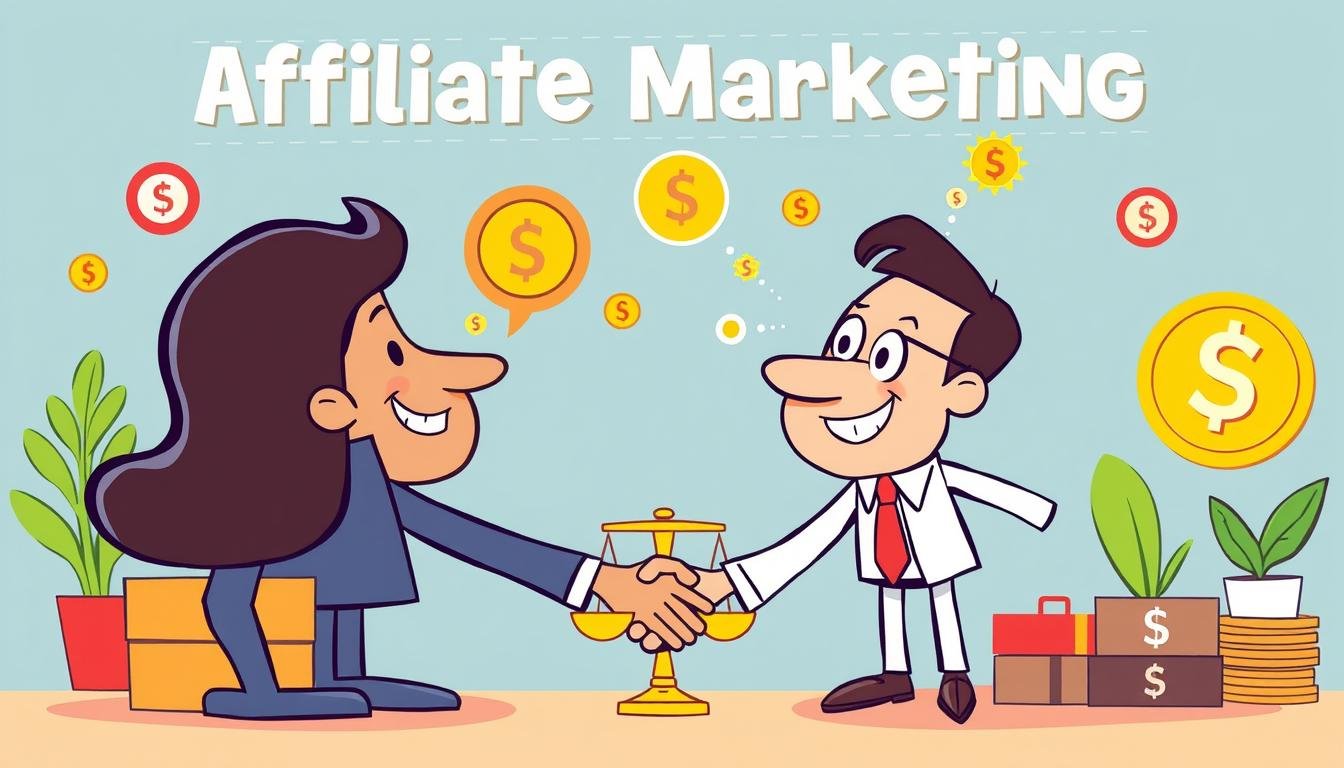Complete Guide to Affiliate Marketing
Did you know that 79% of online companies use affiliate marketing? This shows how powerful affiliate marketing is, expected to hit $15.7 billion by 2024. It’s a great way for people to make money online and earn passive income.
This guide will cover the basics, strategies, and tools you need for affiliate marketing. It’s for both beginners and experienced marketers. Learning to work with your audience and affiliate networks is key. With the right strategy, you can make money and help brands grow, succeeding in the online shopping world.
Key Takeaways
- 79% of online companies actively use affiliate marketing.
- Understanding various payment models is essential for maximizing earnings.
- Building a niche audience can significantly enhance affiliate marketing success.
- Many affiliate programs offer commissions ranging from 5% to 20%.
- Leveraging content, especially through blogging, can drive traffic to affiliate links.
- Successful affiliates often collaborate with major networks like Amazon Associates and ShareASale.
Understanding Affiliate Marketing
Affiliate marketing is a way for people and businesses to make money together. It’s a strategy where affiliates promote products or services and get paid for it. This model is clear about its benefits and what it needs to work.
Definition and Key Concepts
The affiliate marketing definition is simple. It’s about promoting products for a commission. The main people in this are:
- Merchant: The one selling the product.
- Affiliate Marketer: The one promoting the product.
- Customer: The one buying the product.
Affiliates get a special link to track sales from their promotions. This shows why it’s key to know how affiliate marketing works.
How Affiliate Marketing Works
Affiliate marketing has different ways to work, but it’s mainly about results. The main types are:
- Pay-per-Sale (PPS): Earn a part of the sale price when a customer buys.
- Pay-per-Click (PPC): Get paid for each click on the merchant’s site.
- Pay-per-Lead (PPL): Earn for every lead, like sign-ups for trials.
Spending on affiliate marketing is growing fast, expected to hit $15.7 billion by 2024. In the U.S., it went from $5.4 billion in 2017 to $8.2 billion in 2022. This shows how big affiliate marketing is becoming online.
Importance in the Digital Economy
Affiliate marketing does more than advertise. It helps brands work with influencers to grow awareness and sales. With 9,600 affiliate services worldwide, new ones can join in. Amazon offers commissions from 1% to 10%, and HubSpot pays $50 for each lead.
Types of Affiliate Marketing Programs
There are many affiliate marketing programs designed to meet various marketing needs and goals. Each type offers unique benefits, so it’s crucial for affiliates to understand their options to increase earnings and improve engagement.
Pay-per-Sale (PPS) Programs
Pay-per-Sale programs are the most common in affiliate marketing. Affiliates get a commission when a sale is made through their link. This model is simple and focuses on real sales. Brands like it because they only pay when a sale happens.
Pay-per-Click (PPC) Programs
Pay-per-Click programs pay affiliates for bringing people to a merchant’s site, even if they don’t buy anything. It’s great for affiliates who are good at promoting products. This model can be less profitable but helps increase website visits.
Pay-per-Lead (PPL) Programs
Pay-per-Lead programs pay affiliates for getting leads, like email sign-ups or contact forms. This is good for brands wanting to grow their customer base. Affiliates who are good at reaching out to people find this rewarding.
Hybrid Affiliate Programs
Hybrid programs combine elements of Pay-per-Sale, Pay-per-Click, and Pay-per-Lead. They offer various ways for affiliates to make money. This includes creating traffic, getting leads, and making sales. This flexibility helps affiliates work better with brands.
| Program Type | Payment Structure | Ideal For |
|---|---|---|
| Pay-per-Sale (PPS) | Commission on sales | Affiliates focused on conversions |
| Pay-per-Click (PPC) | Payment per site visit | Affiliates driving traffic |
| Pay-per-Lead (PPL) | Payment for captured leads | Affiliates generating lead data |
| Hybrid Affiliate Programs | Combination of above methods | Affiliates looking for diverse income streams |
Complete Guide to Affiliate Marketing: Essential Strategies for Success
In affiliate marketing, building a strong base means targeting a specific audience and picking products they’ll love. It’s key to know what your audience likes and needs. This knowledge lets you use affiliate marketing strategies that really connect with people and increase sales.
Building a Niche Audience
Creating a community around a specific interest is vital. A clear niche lets you make content that really speaks to your audience. Use social media, email newsletters, and blogs to reach out.
By talking with your audience, offering helpful advice, and listening to their feedback, you build a loyal group. This bond helps shape their buying choices and leads to long-term success.
Choosing the Right Affiliate Products
Picking the right affiliate products is a key step. Choose products that match your audience’s interests to keep trust and boost sales chances. It’s important to promote products you truly believe in, showing your honesty.
When you pick products that fit your niche, you’re more likely to turn followers into loyal customers.
| Strategy | Description | Benefits |
|---|---|---|
| Understanding Your Audience | Identify pain points and interests of the niche audience. | Higher engagement and conversions. |
| Content Creation | Produce tailored content that addresses audience needs. | Builds trust and authority. |
| Product Alignment | Select affiliate products that resonate with audience interests. | Increased likelihood of sales and retention. |
| Regular Analysis | Review and refine marketing strategies based on performance. | Improved effectiveness over time. |
Affiliate Networks and Programs to Join
Finding the right affiliate network is key to your success in affiliate marketing. Joining popular affiliate programs gives marketers access to many products and helps increase earnings. It’s important to know what makes these networks stand out to make informed choices.
Popular Affiliate Networks to Consider
Here are some top affiliate networks that offer great opportunities:
- AWIN: Leading globally with over 30% of publisher links, AWIN works in more than 180 countries and has over 25,000 brands. It’s known as the top cost-per-sale network in the United States.
- CJ Affiliate: With a huge number of IR500 brands, CJ Affiliate is a reliable platform, featuring more than 3,800 brands worldwide.
- Rakuten: Smaller but focused, Rakuten works with about 1,000 merchants, including big names like Microsoft and Sephora.
- ShareASale: Hosting over 1 million publishers and 30,000 brands, ShareASale offers a broad range of opportunities across various niches.
- ClickBank: Specializing in digital products, ClickBank has paid out over $6 billion in commissions since starting in 1999.
- FlexOffers: Working with over 10,000 advertisers, including big names, FlexOffers provides various solutions for affiliate marketers.
- Avangate Affiliate Network: Focused on software and digital products, Avangate supports over 1,200 affiliates, making it great for tech-savvy marketers.
Evaluating Affiliate Programs for Profitability
To figure out if an affiliate program is profitable, look at commission rates, payment terms, and its reputation. Here are some key points to consider:
| Program Name | Commission Structure | Market Reputation | Support Offered |
|---|---|---|---|
| AWIN | Cost-per-Sale (CPS) | Highly reputed, 90% satisfaction rate among users | 24/7 customer support, extensive resources |
| CJ Affiliate | Varies by brand | Trusted by major brands | Strong partner support and training |
| Rakuten | Cost-per-Acquisition (CPA), CPS | Excellent for quality products | Dedicated account management |
| ClickBank | Percentage of sales | Popular for digital products | Extensive tutorials and support |
Looking closely at these details will help marketers make better choices about affiliate networks and programs. This careful evaluation is key to a successful affiliate marketing journey.
Creating Effective Affiliate Marketing Content
Making content that speaks to your audience is key to getting more conversions. Knowing what content grabs potential customers’ attention helps you send more traffic to your affiliate links. Using a mix of content types helps you reach different people and promote the right products.
Types of Content That Convert
Various content types can boost your conversion rates. Here are some top formats:
- Blog Posts: These articles teach readers about products or services.
- Reviews: Detailed reviews build trust and push people to buy.
- Tutorials: Step-by-step guides show how to use products.
- Comparison Articles: These articles compare similar products to help users decide.
These content types help show off products and their benefits, making people more likely to buy.
SEO Best Practices for Affiliate Marketing
Good SEO is key for making your affiliate content more visible. Here are some top strategies:
- Keyword Optimization: Use relevant keywords to boost your search rankings.
- Meta Descriptions: Write catchy meta descriptions to get more clicks.
- Engaging Headlines: Use headlines that grab attention and keep readers interested.
- Quality Content: Make sure your content is well-written, informative, and fun to read.
By mixing great content with strong SEO, you’ll draw in and keep an audience. This leads to more success in affiliate marketing.
Tools for Affiliate Marketers
Affiliate marketers have many tools to help them work better and get better results. These tools help with tracking, managing content, and analyzing results. Using the right tools makes their work more efficient and effective.
Affiliate Tracking Tools
Tracking tools are key for keeping an eye on clicks and conversions. They give insights on which campaigns work best. Some top choices are:
- ShareASale, which lets users earn based on how well campaigns do.
- Flippa, a place to buy and sell websites with good backlinks.
- MonsterInsights, with detailed analytics on how users interact with websites.
Content Creation and Management Tools
Creating great content is crucial for affiliate marketing success. Tools help make content engaging and keep things organized. Some top picks are:
- Grammarly for checking grammar and spelling.
- Hemingway app, which makes sentences easier to read.
- Yoast SEO plugin, which helps content rank better on search engines.
Analytics Tools for Performance Measurement
Analytics tools are key for checking how well affiliate marketing campaigns do. They give important data for making decisions. Consider these options:
- SEMRush for finding keywords and looking at competitors.
- Ahrefs, focusing on backlinks and checking website quality.
- Google Analytics, with lots of info on website traffic and user actions.
| Tool | Type | Pricing | Key Features |
|---|---|---|---|
| SEMRush | Analytics | Starts at $119.95/month | Keyword research, SEO auditing, competitor analysis |
| Grammarly | Content Management | From $12/month | Proofreading, grammar and spelling checks |
| Yoast SEO | Content Management | Starts at $99/year | SEO optimization, readability analysis |
| MonsterInsights | Analytics | From $99.50/year | Google Analytics integration, user tracking |
| Ahrefs | Analytics | Starts at $99/month | Backlink analysis, keyword research |
Conclusion
Affiliate marketing is a great way for people to make extra money. By sharing products they love with others, marketers can earn up to 50% of each sale. This makes it a flexible way to work and can lead to a good income.
To do well in affiliate marketing, you need a long-term plan. This includes picking the right products and using different ways to share them. Building trust with your audience is also key. With the right skills and passion, you can make a good living from it.
There are many programs to choose from, like ShareASale, ClickBank, and Shopify. Knowing about commission rates and how to keep customers interested is important. With hard work and creative ideas, affiliate marketing can grow and become a big part of the digital world.
Source Links
- Affiliate Marketing for Beginners: Your Startup Guide (2024) – Shopify
- Affiliate Marketing: Tips, Tricks, and Best Practices for 2024
- How to Start Affiliate Marketing for Beginners (Step by Step)
- The Ultimate Guide to Affiliate Marketing in 2024
- Affiliate Marketing 101: What it is and How to Get Started
- Ultimate Guide to Affiliate Marketing | From Beginner to Expert
- A Complete Guide to Affiliate Marketing Platforms – Blog Tapfiliate
- Affiliate Marketing For Beginners: What It Is + How to Succeed
- Mastering Affiliate Marketing: Essential Strategies for Success
- Affiliate Marketing – A Simple Step by Step Guide
- The Complete Guide to Affiliate Networks for 2024
- 11 Best Affiliate Networks for Marketers in 2024 – Shopify
- What Is Affiliate Marketing? Everything You Need to Know in 2024 – Shopify
- A Step-by-Step Guide to Setting Up Your Affiliate Marketing Business
- Affiliate Marketing Tools: The 27 Tools Every Marketer Needs
- 40+ Affiliate Marketing Tools Every Marketer Needs in 2024!
- A complete guide to affiliate marketing
- Affiliate Marketing – The Complete 2024 Guide
- A Comprehensive Guide To Affiliate Marketing For Beginners – Mapplinks








